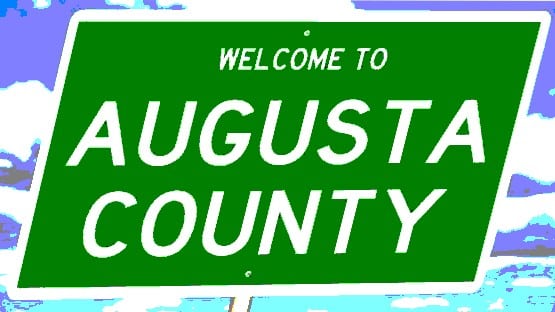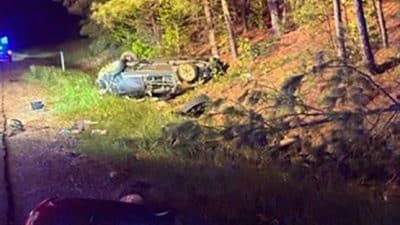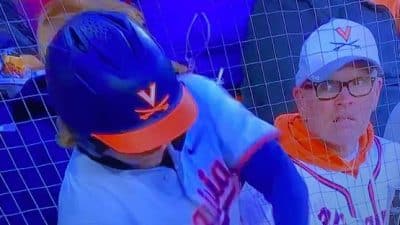Golf Things Considered column by John Rogers
[email protected]
In a subtle, pleated-pants way, golf has potential for those transcendent moments when we feel larger than life, when we go beyond our personal limits. It’s very rare, though, that achievements on the golf course rise to heroic.
In my mind there was only Ben Hogan struggling to finish, yet winning, the 1950 U.S. Open just months after his legs were ravaged in a life-threatening car accident. But on a November day in Virginia Beach I witnessed something special. It was as if Ian Frazier rose up and wrestled with the fates, like Jacob taking on the angel of God.
It might not sound like much – that Ian walked nine holes that day and played an alternate-shot tournament. It might not sound like a big deal that Ian made the first three putts he faced that day. At first glance, it might not seem impressive that Ian made it through nine-holes-worth of swings without missing the ball once. But his round was one of the greatest displays of mental focus and physical triumph I’ve ever seen on a golf course.
Ian’s 28-year journey to Virginia Beach is the history of a man who has clawed out a beautiful existence in a life that barely gave him a start. Ian spent the first three months of his life breathing the clinical air of a Neonatal Intensive Care Unit in North Carolina, where his father, Alan, was stationed with the Marine Corps. Ian likely had a stroke in the womb that led to his premature birth, and when he finally went home on his original due date, his battles had only started.
Ian’s mother, Terrie, thought she saw some early developmental problems. The right side of Ian’s body did not seem to be progressing. As months passed, Terrie began to suspect that there might be sight and hearing issues, too. Ian had a habit of pulling himself into a corner and facing outward as if to guarantee that he could see someone coming.
Their pediatrician dismissed Terrie’s concerns at first, calling her “overprotective.” But an EEG showed drastic abnormalities in the brain. Ian had cerebral palsy.
Confronted with the truth, the pediatrician then advised Terrie and Alan to institutionalize their child. Ian would never be able to do anything, he said. But Ian’s fate was not going to be determined so flippantly. That was the last any of them saw of the pediatrician.
On July 11 of this year, a young man in blue jeans and a T-shirt arrived at my driving range, walking as he does with a little hitch, and a deliberateness that suggests that he is concentrating on his steps. He carried his bag of left-handed clubs up to the hitting mats, where he strapped a glove on both hands and went to work – an indecisive posture, his baseball cap cocked one way and his head cocked slightly the other so that he can look at the ball with his left eye. He pulled his arms into a backswing, wrapping them both around his torso, and then the club came bouncing down, sometimes on the ball, sometimes on the mat.
A few weeks earlier, a lady stopped by my teaching area to ask if I would be willing to coach her son. Terrie seemed a willful and sincere person, and she wanted to know if I would also be Ian’s partner in some upcoming Special Olympics tournaments. So we had our first practice session in July. Ian was quiet, speaking in a low tone, and only after weighing my words first.
I did not know at that time that Ian was blind in his right eye, and I did not know he had suffered through 20 surgeries to stand there in front of me listening to advice about his golf swing. He had nine painful surgeries on each ear so that he could get almost 80 percent hearing. And he had two surgeries on his right leg to make it possible for him to stand and walk.
I did not know that he did not speak until age five. Did not know that he was more than an athlete for Special Olympics; he is also a highly demanded Global Messenger for the organization, traveling across Virginia to speak about the Special Olympics and his disability. I did not know what an indomitable spirit lived inside that weathered body. And I didn’t know that it was Ian who would turn out to be the real teacher in our relationship.
In the weeks following our first meeting, Ian and I prepared for our first tournament. Terrie dropped him off at the course, Ian warmed up at the range, and then we’d take a cart out and play a few holes of alternate-shot golf, taking turns hitting the ball. Ian missed the ball about every second or third swing, and generally only hit the ball about 20 to 40 yards when he made contact, but we had fun, and we scrambled for occasional pars and bogeys.
When he missed the ball, Ian would say, “Of course, that was a practice swing.” We started calling these “bones,” named for Ian’s previous coach, who encouraged practice swings. So we laughed, and practiced, and tried to keep the “bones” to minimum.
On a bright day in September, Ian and I met at Heritage Oaks Golf Course for our first tournament. We rode a cart for nine holes and shared the afternoon with our playing partners, one coach and one athlete, just like us. The other coach made it clear from the beginning that the tournament was for fun and that we should not worry too much about the details. So, when Ian had a “bones,” instead of counting the stroke and making it my turn, Ian just kept swinging until he made contact. In this fashion, we went around the course having a great time, and finishing in 56 strokes.
After our first tournament, Ian and I set our sights on the Fall Championships of the Special Olympics, which were coming up in November in Virginia Beach. We continued to practice together, and I learned more about my new partner and friend. I learned that he works at Friendship Industries in Harrisonburg, a company that hires and trains people with disabilities. I learned about his speeches as a Global Messenger, one of which he concluded by saying that it was his goal for people to see him first and his disability last.
I figured something else out, the more time I spent around Ian. When it comes to family and friends, it’s never a question of the sacrifices others have made for Ian; it’s about the way Ian enriches the lives of everyone around him. Terrie, who knows Ian as the kind of person to comfort others, believes that “God sent Ian to me for a purpose, and that it was to open my eyes to a love so overwhelming that it can’t be described.”
I also learned that Ian responds to confidence. After a really good shot, or when he drained a nice putt, I started saying things like, “Maybe we better call ahead and warn all those other teams in Virginia Beach,” or “Man, they just don’t know what’s going to hit them.” These comments always got a big smile, and I think there was a little bit of a strut in Ian’s measured steps.
Then Ian got a boost from Annika Sorenstam. A few weeks before our Championship, he saw an instructional segment on The Golf Channel, and he came to our next practice really pumped up. On the first hole, he took one of the new irons his father provided, his “magic” six-iron, and knocked a shot onto the green from about 85 yards. We shouted and high-fived, and I made my usual comment that our opponents in Virginia Beach better look out. Ian said, “Yeah, they better look out for the ‘Soren-storm’ that’s going to hit.”
He imagined playing with Annika and Tiger in the gallery. And he developed a new habit. After a good shot, Ian started taking the club in his left hand, making a motion like he was going to toss it in the air, releasing it briefly, and snatching it out of sky with a flourish. It was his equivalent of the Tiger fist-pump.
I arrived at the hotel in Virginia Beach the night before our tournament, in time for the opening ceremonies of the Fall Championships of the Special Olympics of Virginia. The ceremonies included an actual Olympic flame, a pep rally, a dance, and an all-around festive atmosphere. Ian was one of the speakers at the ceremonies, and he spoke with a clarity and forcefulness that I did not expect from my usually quiet friend. In front of hundreds of athletes and thousands of family members and volunteers, he summoned a strength I had not seen before.
The next morning found us at the First Tee of Hampton Roads, an executive course where we would play our nine-hole, alternate-shot tournament. This time we were going to walk, and we were expected to play strictly by the rules. I told Terrie I worried about how much fun it would be for Ian if he had a large number of “bones” and kept losing his turn.
When the time came, we walked out to the sixth tee, where we started. Along with Ian and me, there was another two-man team, Ian’s parents, caddies for each athlete, and a scorekeeper. Quite a gallery compared to our first tournament, even if it did not include Annika and Tiger.
Early on, I was preoccupied with the pressure of trying to hit shots worthy of a coach and club pro. Then I realized that I had made a mistake by not looking at the scorecard before the round – the odd-numbered holes were longer, and I should have been teeing off on those instead of the shorter, even-numbered holes. I was also worried that my putting stroke, a bit yippy of late, would hold up with a gallery looking over my shoulder. And I wanted to stay competitive with the other players, who birdied the first hole after the athlete hit his approach to eight feet and the coach made the putt.
Meanwhile, Ian made a three-footer on the first hole, a two-footer on the second, and a four-footer on the third, all solid putts, and his tempo on the full-swing looked great. He looked really focused as he took a practice swing or two, and then stepped up and hit each shot. He was pushing his tee shots a little, but we only got in trouble on our fifth hole when his tee shot squirted left into the knee-high grass.
It wasn’t until there was a backup on the seventh tee that I realized what was happening. While I worried about my swing, and my putting stroke, and the order we hit from the tees, Ian had played without missing a single shot. In practice, he occasionally even whiffed a chip; but at the Championships, through six holes, he hit every chip (of which there were plenty, because I kept missing the greens with my turn), got the ball moving forward on every full shot, and made every putt inside of five feet.
The eighth was a short par-three. I blocked the ball again, leaving Ian 10 yards right of the green. He took his wedge, took a couple practice swings, and chipped the ball inside of two feet, saving our par and earning applause from the gallery. On our final hole, he teed off with a five-wood, knocking it about a hundred yards right down the middle. He gave the club that little toss-and-snatch move, and strode down the fairway.
After the tournament, Ian paced back and forth waiting for the awards ceremony. He was waiting for the silver medal that 43 strokes earned in our division. He had gone the entire tournament without a single “bones.” I have never played, nor have I seen, a finer round of golf. We both got medals, but I knew who was the champion; I knew who had beaten the odds again; and I knew who was giving the lesson.
There are no famous photographs like the black-and-white of Hogan’s approach on the final hole of the 1950 U.S. Open. It was a just a modest fall day on an executive course in Virginia, without any of the top players in the world. But it was a performance I won’t forget.
An EEG might say there’s something wrong, and the stubborn body has fought him all his life, but Ian showed that day how a spirit of strength can rise from the heart of a true champion.










